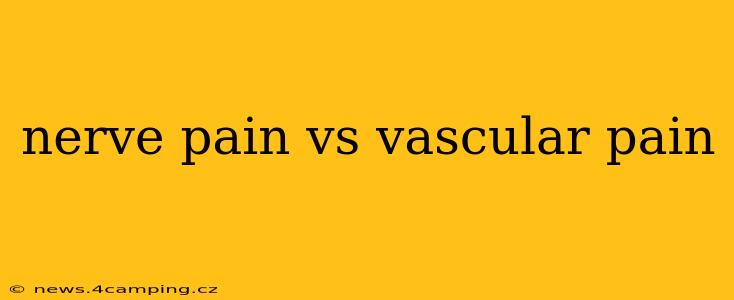Differentiating between nerve pain (neuropathic pain) and vascular pain can be crucial for accurate diagnosis and effective treatment. While both can cause significant discomfort, their underlying causes, characteristics, and management strategies differ considerably. This comprehensive guide will explore the key distinctions between these two types of pain, helping you better understand your symptoms and communicate effectively with your healthcare provider.
What is Nerve Pain (Neuropathic Pain)?
Nerve pain, also known as neuropathic pain, arises from damage or dysfunction of the nervous system. This damage can occur anywhere along the nerve pathway, from the peripheral nerves in your extremities to the central nervous system in your brain and spinal cord. The pain signals are often amplified or misinterpreted by the nervous system, leading to chronic and debilitating pain.
Characteristics of Nerve Pain:
- Burning, tingling, or shooting sensations: These are common descriptions of nerve pain, often described as an electric shock-like feeling.
- Numbness or hypersensitivity: Affected areas may feel numb or excessively sensitive to touch, temperature, or even light pressure.
- Chronic and persistent pain: Nerve pain tends to be long-lasting and can be difficult to manage.
- Location varies: Can be localized to a specific area or radiate along the nerve pathway.
Causes of Nerve Pain:
- Diabetes: Diabetic neuropathy is a common cause of nerve pain.
- Shingles: The varicella-zoster virus can cause nerve pain.
- Multiple sclerosis (MS): This autoimmune disease can damage the myelin sheath protecting nerves.
- Injury: Nerve damage from trauma, surgery, or compression can cause pain.
- Certain medications: Some medications have nerve damage as a side effect.
What is Vascular Pain?
Vascular pain originates from the blood vessels. It's caused by problems with blood flow, blood pressure, or the structure of the blood vessels themselves. This pain is often associated with changes in blood flow, such as constriction or dilation of blood vessels.
Characteristics of Vascular Pain:
- Throbbing or aching: Vascular pain is often described as a throbbing or aching sensation.
- Localized to the affected area: The pain is usually confined to the area where the blood vessel problem is located.
- May worsen with activity: Pain can increase with physical exertion that increases blood flow to the area.
- Can be accompanied by other symptoms: Such as swelling, redness, or changes in skin temperature.
Causes of Vascular Pain:
- Migraine headaches: The throbbing pain of a migraine is linked to changes in blood vessel size and blood flow in the brain.
- Peripheral artery disease (PAD): Narrowing of the arteries in the limbs can cause pain, especially during exercise (claudication).
- Raynaud's phenomenon: This condition causes spasms in blood vessels, leading to pain, numbness, and discoloration in the fingers and toes.
- Inflammation of blood vessels: Conditions like vasculitis can cause inflammation and pain in the affected blood vessels.
How are Nerve Pain and Vascular Pain Diagnosed?
Diagnosing the source of your pain requires a thorough medical evaluation. Your doctor will likely review your medical history, conduct a physical examination, and order diagnostic tests. These may include:
- Nerve conduction studies (NCS): Assess the speed and efficiency of nerve signals.
- Electromyography (EMG): Evaluates the electrical activity of muscles.
- Blood tests: Check for conditions like diabetes or autoimmune diseases.
- Imaging tests: Such as MRI or CT scans to visualize blood vessels or nerves. Doppler ultrasound can assess blood flow.
Treatment for Nerve Pain and Vascular Pain
Treatment options for nerve pain and vascular pain vary depending on the underlying cause and the severity of the pain.
Nerve Pain Treatments:
- Medications: Pain relievers, antidepressants, anticonvulsants, and topical creams can help manage nerve pain.
- Physical therapy: Can improve nerve function and reduce pain.
- Injections: Corticosteroids or other medications may be injected near the affected nerve.
- Surgical interventions: In severe cases, surgery may be necessary to repair damaged nerves.
Vascular Pain Treatments:
- Medications: Blood thinners, vasodilators, and other medications can improve blood flow.
- Lifestyle changes: Exercise, a healthy diet, and smoking cessation can help improve vascular health.
- Procedures: Angioplasty or surgery may be needed to widen narrowed arteries.
What are the common symptoms of nerve damage?
Common symptoms of nerve damage include tingling, numbness, burning, shooting pain, and hypersensitivity. The location and severity of symptoms depend on the specific nerve affected.
What are the signs of vascular disease?
Signs of vascular disease can vary depending on the specific condition and the location of the affected blood vessels. Common signs include pain, especially in the legs or arms during exercise (claudication), swelling, changes in skin color (pallor, redness, or bluish discoloration), and cold extremities.
How can I tell if my pain is nerve-related or vascular-related?
Differentiating between nerve and vascular pain can be challenging and often requires professional medical evaluation. However, consider the characteristics of the pain (burning/tingling vs. throbbing/aching), location, and any associated symptoms (numbness, swelling, changes in skin color). A detailed medical history and physical examination by a healthcare professional are crucial for accurate diagnosis.
This information is for educational purposes only and should not be considered medical advice. Always consult a healthcare professional for diagnosis and treatment of any medical condition.
